路由器介绍及演示
WCF中间件的路由功能是在客户端与服务端之间加入中介服务,用来转发它们之间的消息。实现消息的转发可以修改WCF服务消息头的内容,重新指定服务地址即可,那给消息头指定的服务地址从哪来,需要给路由器配置服务端地址目录,路由器与服务端肯定不是一对一的,路由器可以指定多个服务端,而路由器把客户端连接指定给哪个服务端这里就有一个算法,算法的优劣就决定了中间件负载均衡的能力。
下面演示了中间件的路由功能,把Out目录中的程序复制6份,分别改名如下,3个客户端,1个路有中间件,2个服务中间件,还要修改每个程序的相关配置;这样先启动路由中间件Router和服务中间件WCFservser1、WCFServer2,然后分别启动2个客户端程序,路由中间件和服务中间件就会显示客户端的连接信息。3个客户端会有2个分配到一个服务中间件,一个客户端分配到另外一个服务中间件,不会说3个客户端都分配到1个服务中间件,这是由路由中间件的负载均衡算法决定的;
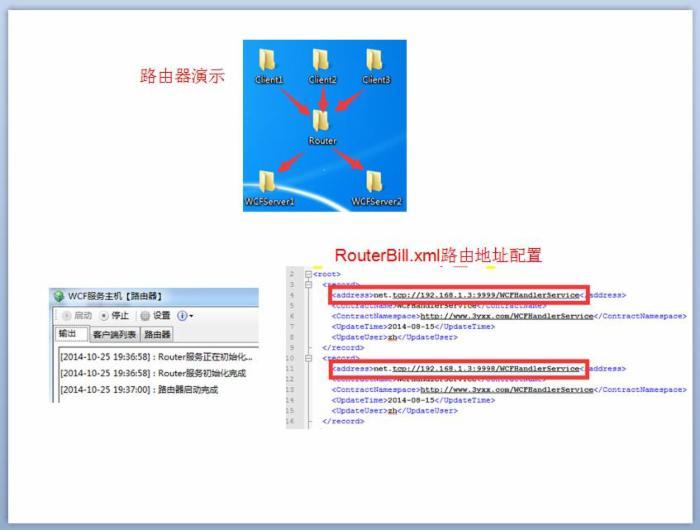
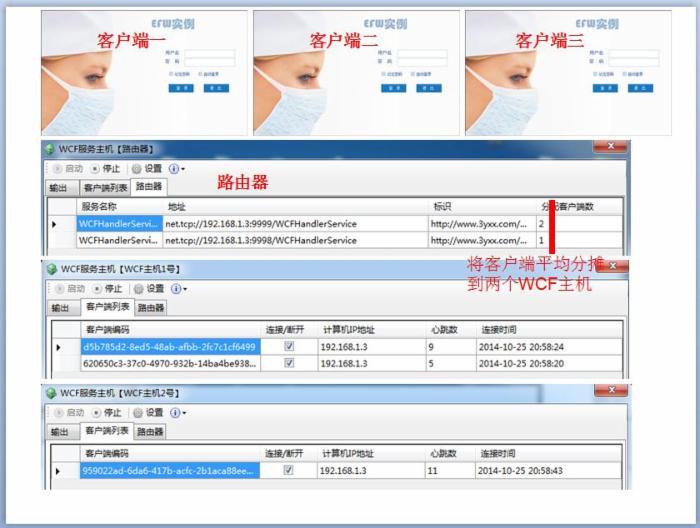
路由功能的实现
框架增加了一个路由服务对象Router,用它来拦截客户端发送的消息,拦截方法ProcessMessage(Message requestMessage);
首先根据路由目录结合负载均衡的算法取得服务地址endpointAddress,然后创建WCF通道并绑定新的服务地址,调用服务端的方法;
- /// <summary>
- /// 截获从Client端发送的消息转发到目标终结点并获得返回值给Client端
- /// </summary>
- /// <param name="requestMessage"></param>
- /// <returns></returns>
- public Message ProcessMessage(Message requestMessage)
- {
- //Binding binding = null;
- EndpointAddress endpointAddress = null;
- GetServiceEndpoint(requestMessage, out endpointAddress);
- IDuplexRouterCallback callback = OperationContext.Current.GetCallbackChannel<IDuplexRouterCallback>();
- NetTcpBinding tbinding = new NetTcpBinding("netTcpExpenseService_ForSupplier");
- using (DuplexChannelFactory<IRouterService> factory = new DuplexChannelFactory<IRouterService>(new InstanceContext(null, new DuplexRouterCallback(callback)), tbinding, endpointAddress))
- {
- factory.Endpoint.Behaviors.Add(new MustUnderstandBehavior(false));
- IRouterService proxy = factory.CreateChannel();
- using (proxy as IDisposable)
- {
- // 请求消息记录
- IClientChannel clientChannel = proxy as IClientChannel;
- //Console.WriteLine(String.Format("Request received at {0}, to {1}\r\n\tAction: {2}", DateTime.Now, clientChannel.RemoteAddress.Uri.AbsoluteUri, requestMessage.Headers.Action));
- if (Convert.ToInt32(HostSettingConfig.GetValue("debug")) == 1)
- hostwcfMsg(DateTime.Now, String.Format("路由请求消息发送: {0}", clientChannel.RemoteAddress.Uri.AbsoluteUri));
- // 调用绑定的终结点的服务方法
- Message responseMessage = proxy.ProcessMessage(requestMessage);
- // 应答消息记录
- //Console.WriteLine(String.Format("Reply received at {0}\r\n\tAction: {1}", DateTime.Now, responseMessage.Headers.Action));
- //Console.WriteLine();
- //hostwcfMsg(DateTime.Now, String.Format("应答消息: {0}", responseMessage.Headers.Action));
- return responseMessage;
- }
- }
- }
#p#负载均衡的实现
负载均衡实现代码在Router对象中的GetServiceEndpoint方法中,定义了RegistrationList对象用来存储客户端列表,在消息头中增加了两个标识routerID和CMD,routerID用来识别客户端,值是客户端创建发送到路由中间件,每个客户端只有一个routerID;CMD用来客户端发送给路由中间件的命令标识,这里只用到了一个就是”Quit”就是卸载路由中间件中的RegistrationList客户端列表;
解决了识别客户端的问题,那平均算法每个客户端分配到哪个服务中间件就很简单了,RoundRobinCount就记录每个服务中间件对应的客户端个数,哪个服务中间件数量少新的客户端就分配给它;
- private void GetServiceEndpoint(Message requestMessage,out EndpointAddress endpointAddress)
- {
- string ns = "http://www.3yxx.com/";
- string routerID = GetHeaderValue("routerID", ns);
- string cmd = GetHeaderValue("CMD", ns);
- string contractNamespace = requestMessage.Headers.Action.Substring(0, requestMessage.Headers.Action.LastIndexOf("/"));
- RegistrationInfo regInfo = null;
- if (Router.RoundRobinCount.ContainsKey(routerID))
- {
- int key = Router.RoundRobinCount[routerID];
- regInfo = Router.RegistrationList[key];
- if (cmd == "Quit")
- {
- regInfo.ClientNum -= 1;
- }
- }
- else
- {
- //根据指定的协议名称空间从注册表容器中得到注册项列表
- var results = from item in Router.RegistrationList
- where item.Value.ContractNamespace.Contains(contractNamespace)
- orderby item.Value.ClientNum ascending
- select item;
- if (results.Count<KeyValuePair<int, RegistrationInfo>>() > 0)
- {
- var val = results.First<KeyValuePair<int, RegistrationInfo>>();
- Router.RoundRobinCount.Add(routerID, val.Key);
- val.Value.ClientNum += 1;
- regInfo = val.Value;
- }
- }
- Uri addressUri = new Uri(regInfo.Address);
- //binding = CustomBindConfig.GetRouterBinding(addressUri.Scheme);
- endpointAddress = new EndpointAddress(regInfo.Address);
- //重设Message的目标终结点
- requestMessage.Headers.To = new Uri(regInfo.Address);
- hostwcfRouter(RegistrationList.Values.ToList());
- }
WCF客户端配置和中间件配置还有路由地址配置
如果部署的时候不使用中间件的路由功能,那客户端配置服务地址直接指定服务端WCF地址就行了,而如果启用路由功能,那客户端就配置路由中间件的WCF地址,路由中间件再配置路由目录,对应服务端;
客户端WCF配置和服务端WCF配置还有一个地方值得注意,就是netTcpBinding节点的配置;***
1)客户端App.Config配置
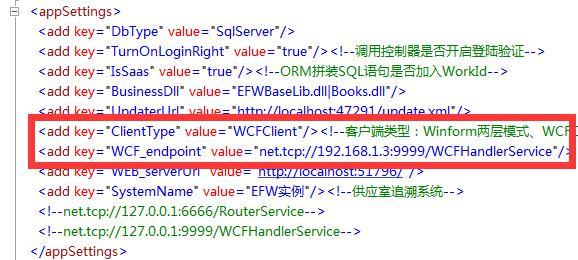
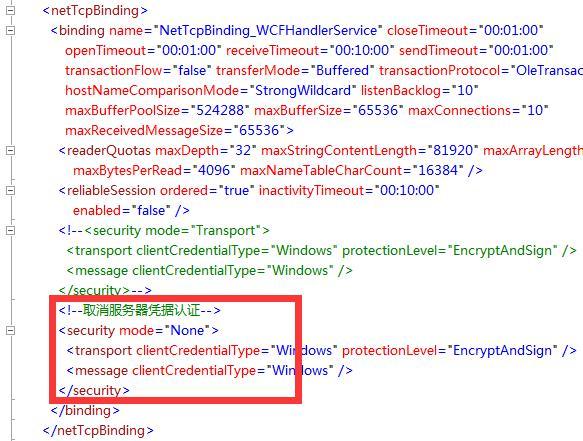
2)路由中间件App.Config配置和路由目录RouterBill.xml配置

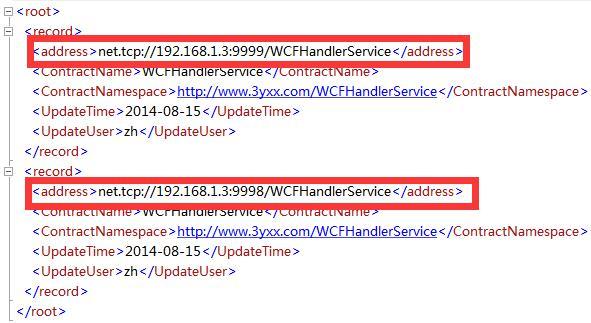
3)服务中间件App.Config配置
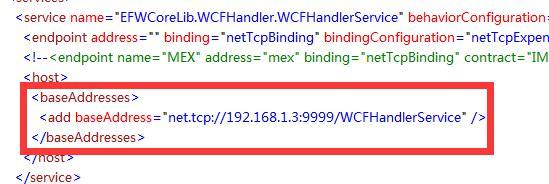
5.总结
本章我们详细讲解了EFW框架中的WCF中间件的路由功能和负载均衡的实现,代码很简单,但深入理解却没那么容易,我也只是略懂点皮毛,参考了网上资料把功能实现而已,而想要做成专业级别的中间件是有一个过程的,所以不只是我,也需要有兴趣的人一起完善它;
路由实例程序下载 :http://pan.baidu.com/s/1eQ8FscE
注意:实例中的配置文件中的IP地址192.168.1.3修改为你本机的IP地址;

























